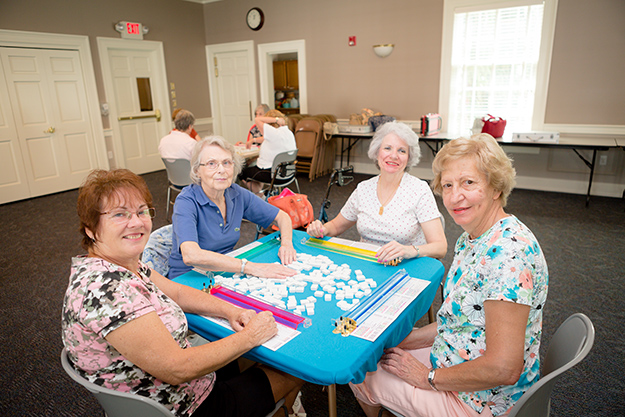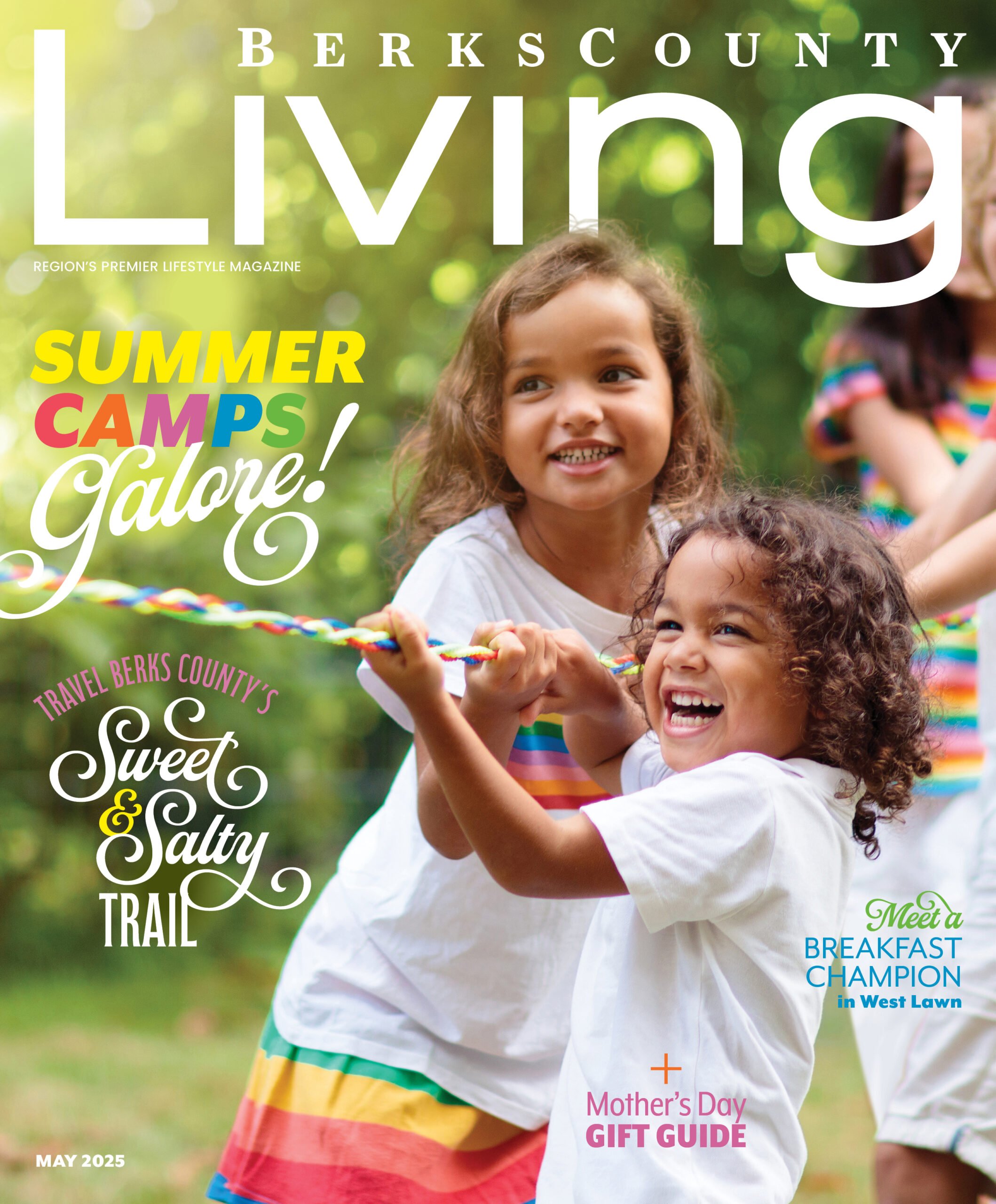Fun doesn’t have an expiration date.
Throughout Berks County, seniors are making friends and nurturing pets. They’re traveling, staying fit, and keeping sharp with a challenging game. They’re living well. They’re having fun.
Seniors for the most part are finished with raising children, done with full-time work and no longer worried about saving for education and retirement. That leaves a lot more time for fun.
Here’s a sampling of four ways Berks County seniors are having fun. Because, as Cyndi Lauper says, isn’t that all we really want?
Shaking their Stuff at The Heritage of Green Hills
If you never got around to belly-dancing, becoming a meditation master or dancing on top of a bar by retirement age, regret it no more.
The Heritage of Green Hills has an exercise and wellness program that makes room for all of these wishes. It’s creative, and it’s popular enough that close to 90 percent of residents participate. That’s impressive for any group, especially for older generations who haven’t had decades of a gym habit.
The program is part of the Cumru Township community’s focus on the eight dimensions of wellness: spiritual, emotional, social, vocational, intellectual, physical, health services and environmental.
“It’s all about body, mind and spirit,” says Cheryl Anderson, Well By Design Director.
And these bodies are active. They hike Hawk Mountain. They go biking.
On the nutrition side, the Heritage’s chef will make 450-calorie entree options, which usually sell out. Yes, there’s comfort food like the popular cheesesteaks, but the chef also adds things like seaweed and quinoa to the menu.
Exercise is an important part of the eight dimensions. Residents can sign up for fitness classes by land and sea, Anderson jokes.
There are activities like water volleyball and water Zumba in the Olympic-sized pool. On land, they can take classes like tai chi, qi gong and tap dance. Or they can schedule a session with personal trainer Mark Sweigart.
In the gym, the equipment doesn’t face windows or the walls. The machines face the center of the room, making the workouts a social experience. That social experience makes exercise fun, something to share with others.
One resident told Anderson she worried her exercise class looked silly to those passing by, but then she saw the results in her balance and posture. No more worrying.
There are also seated exercise options and lower-impact classes like tai chi and qi gong (pronounced CHEE-gung) that focus on slow, deliberate movements.
Back to the belly dancing, though.
Anderson called in a professional instructor and handed out little skirts edged with coins. It’s all about trying something new.
“I want you to do the things you never had time to do,” Anderson says to residents.
One woman mentioned she always wanted to dance on top of a bar.
“They helped her,” Anderson says. “And she got to shake her little butt on the bar.”
Who knows...maybe even another exercise class.

The Mah Jongg Mind Game
Maryanne Post learned to play Mah Jongg one summer at the Jersey shore. The game was kind of like an involved game of rummy with pretty tiles. Beyond the strategy she saw the friendships formed around the table.
Back home, she wondered, "wouldn’t it be nice to share this game with Berks County?"
Post asked the Wyomissing Public Library for space, and when she got the okay, she sent out the word. About 20 people showed up, and they’ve been playing together for the past four years.
Yes, there’s the game. But there’s also what happens when people get together every week and challenge each other.
“It’s just so gratifying to me to see the friendships that have formed,” Post says.
The game (pronounced mah-jong) dates back to the age of Confucius, around 500 B.C. After English numbers were added to the tiles in the early 20th century, the game reached craze level in the United States. The popularity has faded, but it has a steady and devout following.
Mah Jongg is a game played with tiles. You play against yourself in groups of four and try to match the tiles to a hand on a Mah Jongg card.
It takes perseverance for beginners to get the game, but they should be comfortable within a few games, Post says.
Through the years, a group of 20 to 30 has gathered on Wednesdays to play Mah Jongg at Wyomissing Public Library from 11:30am to 2pm. The ages range from 30s to 80s, but most are retired. Experienced players can rush through 10 games in that time.
They return every week because it’s an invigorating game that keeps them mentally sharp.
“It keeps the mind challenged,” says Eileen Kope of Flying Hills.
Having a new card every year changes the rules and levels the playing field, says Pam Harter of Cumru Township. “It’s always changing,” Harter says.
Outside of the game, the group often meets for breakfast and lunch or organizes indoor picnics at the library.
“We meet every week. We have fun, laugh and joke around,” Kope says.
Organizers encourage people to sit in a different place each visit to meet new people.
The library saw welcoming the club as an opportunity, Director Colleen Stamm says. “We didn’t have anything like this,” she explains. “And we’re trying to expand our adult programming.”
The group offers free Mah Jongg lessons, usually once a year depending on the demand. Experienced players can join without lessons. The next group will start in the fall based on interest.
Mah Jongg Tips for Beginners
-
- Take a class, like the ones offered at Wyomissing Public Library.
-
- Be patient. It will come to you.
-
- Don’t get discouraged.
-
- Read A Beginner’s Guide to American Mah Johngg by Elaine Sandberg.
-
- Practice, practice, practice, especially with an experienced player.
For more information about the Mah Jongg Group or to sign up for lessons, call the Wyomissing Public Library at 610.374.2385.

Unexpected Residents at Country Meadows
Walk into Country Meadows, and if you’re lucky you’ll see Ike, Dolly, Madison and Amy. This bunch loves sleeping, eating, lounging and lots of attention.
Along with Oswald, the albino bunny, they’re the Wyomissing retirement community’s resident pets.
The furry friends bring a lot of warmth to the community for both residents and staff. Having the companionship of a pet can improve well-being. Plus, pets don’t talk back.
Take Ike the cat, who brings a calming sense about him, says Missy Lengle, Director of Business Development and Education. “They can sit and pet him, or he’s hanging around. There’s an animal in the house,” she says. “For a lot of people, that makes a really big difference.”
Country Meadows encourages residents to bring their own pets when they move in. There’s also a pet care program for staff to help with things like walking the dog.
For those who don’t have pets of their own, the resident animals spread cheer.
Director of Community Life Kelly Sorrick decided to adopt two cats for the community’s memory support neighborhood seven years ago. She found three at a local shelter and brought them to their forever homes.
On any given day, Ike will spend time in the activity room, where he has a pet bed, food and water. He’ll meander into the lobby to greet residents. And he’ll spend some quality time front and center on the desks of staff members.
“He’s friendly and attention-getting,” says wellness secretary Samantha Theodossiou.
Ike’s also a hugger and loves to be held. Kelly is his main caregiver, but the cat gets treats from staff, residents and visitors alike.
Oswald the rabbit lives in Country Meadows’ Pathways Restorative program. Residents reach into his pen for a pat and to give him treats like blueberries and carrots. If he’s not getting enough attention, he’ll thump his leg.
For dog lovers, Amy is a resident bulldog in the independent living neighborhood.
“She is very spoiled by residents and staff,” Lengle says.
And Dolly and Madison have the run of the memory support area.
Madison will park herself in the middle of the hall, waiting for someone’s attention. Or she’ll climb into a sunny window sill to watch the birds outside. Dolly’s partial to lounging in residents’ rooms and napping on people beds, rather than pet beds.
“They’re good company,” one resident says.

All Aboard the Phoebe Berks Bus
The scrapbooks of a group of travelers from Phoebe Berks should be filled with pictures of the stunning horses at a local farm. There’s Middle Creek Wildlife Management Area, where 60,000 snow geese alight and turn the sky white in front of them. And don’t forget the Christmas light tours.
Oh, the places they have gone.
And they’ve never had to leave the bus. Community Life Assistant Jean Garrett packs everything into a 90-minute trip, so there are no worries about bathroom breaks. While the mobility of the travelers may be limited, their travels are not.
“We look forward to getting out,” says resident Ann Zimmerman, who signs up for many of the trips with her husband, Jimmy.
Before Garrett retired this summer from Phoebe Berks, she organized activities and programs for residents “morning, noon and night,” everything from trivia and bingo to seated exercise and visiting musical acts.
She added monthly trips a few years ago for those in assisted living. The bus is always full when she announces a new trip, which is free for residents of the Wernersville community.
“I try to come up with things that they don’t get an opportunity to do often,” she says.
Garrett has organized trips to see the fall foliage. They’ve gone on a ghost tour at Stokesay Castle. There have been mystery trips, too.
For each trip, Garrett does the research to be the best tour guide she can be and shares details with her travelers on the bus. She also invites people on board to share more, like the time a local farmer talked about growing vegetables.
Sometimes, the action is outside. Zimmerman recalls one trip where they watched horses jump high over obstacles from there seats in the bus.
Garrett works to make the trips exciting, informative and be an enjoyable way to keep the residents active.
Yet travel isn’t just fun. Researchers have found a link between travel and health.
“Those who engage in more leisure activities such as travel are generally healthier and report greater satisfaction in their lives than those who do not,” reported the Global Coalition on Aging.
It’s fun, too.
“You have to see the look on their faces,” Garrett says.
Usually the travelers are in their late 70s through their 90s.
“I want them to have a memory that was an enjoyable time,” Garrett says. “Some of them, if you ask them next week, wouldn’t remember.
“For the moment it’s very important for them,” she says.
By Erin Negley | Photos by Heidi Reuter
















